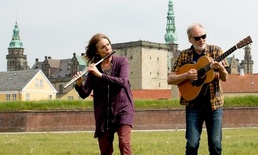Dick Burleson‘s Wild Ride: A Few Words with the Greatest Off-road Motorcycle Racer of all Time
Sept. 8, 2004
When my former college roommate called to tell me that Dick Burleson lived in Traverse City, it sent me immediately back to my childhood. When I was a kid there we handful of people I dreamed of becoming: Jim Morrison of The Doors, Jim Rockford (private eye), Dick Butkiss (Chicago Bears middle linebacker) and Richard “Dick” Burleson.It seems just like yesterday I was running around with neighborhood friends racing bicycles at a nearby gravel pit. On the bike ride over our conversation was always the same, who would get to be Dick Burleson.
“I get to be Dick Burleson,” I would say.
“You can’t be Dick Burleson,” my buddy would respond. “You never win and Burleson always wins.”
“Yeah and plus you don’t even have a real dirt bike and I do,” another would counter.
“Well I am building the official Dick Burleson enduro course in my backyard and you guys won’t be able to ride on it,” I replied.
That finally won them over and I got to be Dick Burleson. Of course the next day we started construction in my backyard on an enduro course while my father was at work. Needless to say when he got home and saw several holes and mounds of dirt in our backyard my Dick Burleson days were over.
BEST OF THE BEST
Oh yeah, just who is Dick Burleson?
Just the greatest off-road motorcycle racer of all time; his string of eight consecutive American Motorcycle Association (AMA) National Enduro Championships from 1974 to 1981 may never be broken. Add eight consecutive gold medals at the International Six Day Trials (World Championships) during the same period and Burleson was
an easy choice for the Motorcycle Hall of Fame’s first induction class of 1998.
In those days there wasn’t ESPN or the Internet. I read about Dick Burleson in my Dad’s monthly motorcycle magazines. Races were also occasionally shown on ABC Wide World of Sports. The lack of immediate media coverage didn’t prevent Burleson from becoming a household name worldwide with motorcyclist race enthusiasts.
Now 56, Burleson doesn’t look a day over 40. He maintains his racing weight of 150 lbs. and is in exceptional shape. He stays fit simply by riding both mountain bikes and dirt bikes as often as possible.
RIDES EVERY DAY
“I am not a gym guy, so I stay in shape riding my mountain bike almost everyday, even in the winter months. I even have a suitcase for it and take it with me when I fly,” said Burleson. “Off-road motorcycle riding is also strenuous exercise, so between the two I stay fit.”
Burleson moved to the Old Mission Peninsula in 1988, seven years after he retired from racing (he retired on top from the circuit but continues to race at certain events even today). So how does one of motorcycling’s greatest racers end up in Traverse City?
“When I retired from serious racing in 1981, I said to myself that I got to keep racing, so I started racing Hobie Cat sailboats,” said Burleson. “I came up to the area racing. In the late ’80s I was doing some contract work with KTM motorcycles in the area of noise control. Well there was this conference on noise control at the Grand Traverse Resort in 1988 and my wife Jill and I toured around after the conference and had lunch on the peninsula. It was May, the sun was shining and blossoms were out and I said ‘let’s move here,’ and we did.”
Prior to moving to the area Burleson was living in Columbus, Ohio where he had been with Husqvarna for years racing their motorcycles and also working as an engineer for their North American operations.He eventually would oversee new model specifications, warranty service and racing programs during his career with them. After 17 years with Husqvarna the company sold so Burleson parted ways and started Dick Burleson Sports.
THE RACING PIE
As CEO of Dick Burleson Sports, Burleson keeps his hands on several pieces of the motorcycle racing pie. He and a partner organize and promote the first race in the Grand National Cross Country series each year. The race is in January in Texas and is part of 13 race series sanctioned by the AMA. He consults and races for Moose Racing, a manufacturer of accessories for motorcycles, ATVs and snowmobiles. Besides being a technical consultant for their various product lines Burleson organizes several rides for company retailers and makes numerous public appearances at races.
Burleson also writes for “Dirt Rider Magazine,” and recently appeared on a show for Dirt Rider that airs on the Outdoor Life Network (OLN). Plans are for him to produce and appear in more shows (his next show will air September 24 at 10:30 p.m. on the Outdoor Life Channel).
Burleson’s popularity with riders and fans of all ages has not diminished over time and he remains in great demand on the circuit.
“It is surprising in a way that the younger racers know me,” said Burleson. “A lot of these kids today learned about me from their dads. My work with various magazines and making public appearances at races keeps my name out there.”
Burleson adds that he has worked hard to maintain his name in racing circles.
“It would have been pretty easy for me to just come up to Traverse City and go boating all of the time. But I would have faded away. You have your 15 minutes in the light. If you don’t work at it after that you are gone. I have worked at it pretty darn hard to keep my name out there. It is amazing to me that it has been 23 years since my last championship but I am still paid to go to races and riding events and schmooze.”
HONDA 90CC
For fans of off-road motorcycle racing Burleson’s accomplishments make him a legendary figure. What is even more amazing is that he didn’t even start riding motorcycles until he was 18.
“Just before I started college I bought a little Honda 90cc to get to and from work,” said Burleson. “I took it with me to college and met up with guys who were trail riders.”
Before long Burleson found himself entering motocross races and enjoying the competition. During his sophomore year (1970) he turned pro and went on to win the National Motocross Championships and finished fourth at the World Championships.
In 1971 he switched to enduro racing and in 1972 qualified for the AMA national team and took a bronze medal at the world championships in Czechoslovakia known in racing circles as the International Six Day Trials.
Burleson graduated from the University of Michigan in 1973 with a mechanical engineering degree. He was hired by Husqvarna as their eastern service manager and moved to Columbus, Ohio. He would continue to race on weekends and even while his fame was increasing, his pay wasn’t.
“It wasn’t like it is today where these sports guys make millions,” said Burleson. “I was on my fifth championship before I saw any real money.”
Even after winning his first National Championship in 1974 and winning the Gold at the International, Husqvarna wouldn’t allow Burleson to quit his day job.
“Racing was something that Husqvarna let me do. It wasn’t a focus at first until after the third championship,” said Burleson. “Even then I still had a full-time job to do with technical and budgetary responsibilities. I had access to good motorcycles and they would pay my expenses. Today a kid wins a local race and the next thing you know he has a motor home and $50,000 a year in sponsorships with all expenses paid.”
PRESSURE TO WIN
Burleson’s success led him to overseeing the Husqvarna race team and a shift in his responsibilities. In 1980 he won his seventh consecutive national championship, tying the legendary Bill Baird’s record, so the pressure to win another championship and break the record must have been intense?
“Beating his record wasn’t a concern. It was never the objective. I teach young racers at the various riding schools this concept, and that is simply the only thing you need to think about is the next 50 feet of trail ahead of you,” said Burleson. “I just took it one foot at a time and one race at a time.”
So why retire when you are on a roll?
“The way it worked it was my job to develop the Husqvarna team and to hire the best racers and I hired guys who were chasing me. By the time I won an 8th championship I didn’t feel I could win another one. I was 33 and I didn’t want to be dragging it out getting second or third so I retired on top. It wasn’t like the money was good enough to hang around to collect a million bucks for finishing second.”
Burleson attributes his success to several factors. First he was athletic in high school and was a runner. In fact the University of Michigan recruited him, but he declined; “I wasn’t a team guy.” At 5’ 7” and 140 lbs. he was also the perfect build for racing. His academic background also helped.
“Certainly by having a mechanical engineering degree from the University of Michigan was not typical of racers in my day. Though I must say my mathematical background helped me win races.”
The object of enduro racing is to negotiate the trail, which is usually wooded, at a prescribed speed with various timed checkpoints where penalty points are assessed for arriving too early or too late. So having strong math and engineering skills played a crucial role in his wins
DOWNHILL MOUNTAIN BIKING
Burleson still hasn’t lost his desire to compete. In the mid-nineties Cannondale (maker of mountain bikes) contracted Burleson to consult with him on developing a line of motorcycles. When Burleson was in Colorado in 1998 making a public appearance at a retailers ride for Moose he learned of a downhill mountain bike race and decided to enter.
“We had a motorcycle dealer ride in Crested Butte and the weekend before that there was a NORBA race in Breckenridge.I talked to my buddy at Cannondale and I said, ‘How about hooking me up with a bike to enter the race.’ Downhill courses are on mountains at ski resorts with woods and boulders and it really appealed to me. For me it was like cheating because it was so similar to motorcycle racing. My downhill bike has the same suspension as my motorcycle and the brakes are way better. It was gnarly stuff and I won. So Cannondale sponsored me and I raced a few events that year and qualified for nationals and won that in Vermont and then went to the World Championship in Mt. Saint Ann in Quebec and won that.”
Burleson won back-to-back National Masters and World Masters Championships. Caring for his ailing parents and the fact that he broke both collarbones within a year of each other retired him from further competitions. He still rides both his mountain bike and trail bike regularly.
“No motorcycle trails on the Old Mission Peninsula, but there are DNR Trails all over by Ranch Rudolph,” said Burleson. “When I first moved up here I used those trails a lot for testing new bikes for various clients. I mountain bike the trails at the end of the peninsula and they are great.”
STRICTLY OFF-ROAD
What about street bikes -- are you a Harley guy?
“I am an off-road guy,” said Burleson. “There is only one reason for pavement and that is to get to dirt.”
So for a guy who has been consumed with a passion for off-road motorcycling for 35 years, could you imagine yourself in another profession?
“Well my father wanted me to be a concert pianist and from the ages of seven to 18 I played the piano,” said Burleson. “But like with a lot of things when a parent pushes and it’s not in the kid’s heart they usually quit and I did and I haven’t played the piano since.”
It’s Cannondales when riding motorless; what is it you ride/race today when an engine is required?
“I ride KTM motorcycles for a couple of reasons,” said Burleson. “First they make a great bike and secondly my son is the chief operating officer for their North American operations. The problem is a little reverse nepotism is happening. He is pretty tight with the budget and doesn’t slide his father any freebies.”
As for the future of off-road motorcycling Burleson believes it is great. While spectators have been drawn into NASCAR, Burleson points to the accessibility of his sport as offering far more opportunities for more to compete than NASCAR.
“There was a time in the ’80s when interest died off, but now it is cool again. Heck, kids in high schools are wearing motorcycle racing shirts who don’t even own bikes. We are getting upwards to 600 to 800 competitors at events. The challenge today is finding the parking to hold the semi-trucks and the motorhomes. Plus finding areas larger enough with tracts of land to have an enduro course.”
So is the competition greater today than it was in your day?
“You hear this in all sports; ‘Competition is a lot tougher today,’ and that is a bunch of bull,” said Burleson. “In some ways it was almost tougher in my day. Bikes were junk compared to today. Equipment has improved all sports from golf to NASCAR.”
Another accomplishment Burleson is proud of is his 33-year marriage to wife Jill. She was at his side during most of his wins.
“When we started dating he needed someone in his crew,” laughs Jill Burleson, who now leaves the “boys play” to Dick and spends her time working with the local garden club.
Dick Burleson shows no signs of slowing down, except for when the grandchildren come to visit, he is always on the go. For loyal fans he will always be known as “King” Richard, a title given to him by the media during his championship run. As for the future, Burleson wakes each day thinking only of the next 50 feet of trail ahead of him and realizing that you have to tackle that before you can get to the next 50 feet: a lesson that serves one well in all trails of life.
Trending

Searching for a Sugar High
In the words of Cookie Monster, “NOM NOM NOM.” It’s cookie season, and we’re here for every gingerbr… Read More >>
Christmas in Sweden (by way of Benzie)
Musical duo Ingemar and Lisa Johansson, also members of Song of the Lakes group, bring “Christmas in Sweden: A Musical… Read More >>
Fighting Harder for Local Women and Children
Traverse Bay Children’s Advocacy Center (TBCAC) has been navigating a particularly challenging year. Though CEO Lande… Read More >>


